For those of you who are new to my work, I created this blog to highlight issues of interest to young women, girls, and their advocates. At my workshops and speaking engagements, girls often ask me how I have the confidence and courage to stand up and speak in front of hundreds of girls. I assure them that I did not always feel confident, courageous, or self-assured. In fact, I felt self-conscious and insecure throughout my pre-teen years (ages 9-13). As a young girl, I struggled to develop a positive identity amidst contradictory messages in the media and American society. These personal experiences inspired my current work as a girls’ studies researcher, educator, activist, and empowerment coach. After I wrote my response to Sesame Street’s “I Love My Hair” video, I felt inspired to share my hair story with my followers.
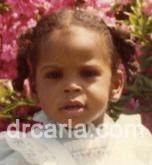
Age 2 or 3
Growing up, I had conflicting feelings about my hair. I needed a “love my hair” intervention during my early childhood when I was embarrassed that I was the only one who had to wear a swimming cap to protect my hair when I went swimming at my predominantly White summer camp in Silver Spring, Maryland (suburb of Washington, DC). Getting my hair washed was a major production that I dreaded because it took several hours for my mother to detangle my thick head of curly hair while I cried at the top of my lungs in protest. Despite the tears, my mother was always patient, gentle, and understanding when she cared for my hair. After she finished combing through the tangles, I pouted while she blow-dried my hair, but I didn’t mind getting it braided. The lengthy and painful hair washing process was always worth it in the end because I liked my pigtails. My father also braided my hair on occasion after my mother got the tangles out, and I fondly remember admiring the braids he created because they were the same width from top to bottom.
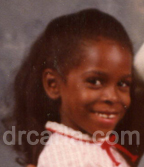
1st Grade
Elementary School
At the age of 5, I wanted to have bangs like my friend Kia, but my mother told me that they were too difficult to take care of without a relaxer; so I took matters into my own hands and found some “grown up” scissors with the long, sharp blades and ended up cutting a bald spot right smack in the middle of my head. My mother gave me a mild spanking and I learned that she did not think that I was mature enough to make decisions about my hair. Typically, my mother gave me “the look” or a lecture when I acted up, so I knew she meant business (she never spanked me again).
When I was six years old, my mother straightened my hair with a pressing comb for the first time in preparation for my 1st grade family portrait. I remember being fascinated with my hair as I turned around backwards in front of the mirror in our living room to see if it reached my waist like my Asian friend Marlene’s (it didn’t). I ran my fingers through it and practiced flinging my hair around like the Solid Gold dancers I idolized (Note to my teen readers: Yeah, I really am that old). As I danced around, I decided that it was more grown up and emphatic to “whip” my newly straightened hair back and forth than my pigtails.
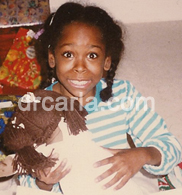
Age 9 (I still remember how excited I was when I held my brown Cabbage Patch Kid doll for the first time…lol)
I got my first set of cornrows in the third grade. Even though I hated sitting still during the long hours that it took my mother to adorn my hair with small braids, I loved my cornrows because I enjoyed listening to the sound of the beads clicking together whenever I moved my head. I also discovered that it was fun to run and dance around with hair that made music. And I liked feeling special and unique when my cornrows fascinated the non-Black children in my school. I only disliked wearing cornrows when we played “Silent Speed Tag.” I tried my best to tip toe quietly around the classroom, but my peers always guessed when I was “it” because they could hear my noisy braids even though their eyes were closed.
Middle School
The transition to middle school is often difficult for girls and I was no exception. As I grew older, I longed for independence and wanted to style my own hair. However, I had no idea how to properly care for it, so I continued to depend on my mother to maintain it. During those awkward years, I noticed that the Black and biracial girls with long and wavy or straight hair got the most attention from my Black male peers, while the girls with kinkier hair were overlooked. The girls with relaxed hair and trendy hair styles such as “crimps” and asymmetrical cuts were also popular. I longed to be accepted, popular, and desirable, so I envied the girls with relaxed hair and cool hairstyles that I wasn’t allowed to wear (I typically wore my hair in a french braid). I was always disappointed whenever it rained because my hair got frizzy and my bangs stuck straight up in the air. At that stage of my life, I wanted to look like Salt-N-Pepa, but I felt more like Don King (I’m dating myself lol).
When I conduct body image and empowerment workshops for girls, I sometimes ask the participants if they ever feel like they “hate their hair.” Every time, most of the girls raise their hands and enthusiastically share examples of their “bad hair days.” I have shared this sentiment on more occasions than I care to admit. On one humid morning in the 7th grade, I felt extremely bothered and frustrated with my poofy hair, so I snuck downstairs into the kitchen to secretly straighten my bangs. This was a big deal because I wasn’t allowed to use the pressing comb by myself because it had to be heated up on the stove (I was accident prone). I ended up burning off a section of my hair because the pressing comb was too hot and I didn’t know how to use it properly (this happened before ceramic flat irons became popular). I panicked and poured water on my hair because I was afraid that I would catch on fire. When I looked in the mirror, I couldn’t believe the sight of my scorched hairline because the ends had broken off and turned white and the wet section had become curlier than the rest of the hair on my head.
In that moment, I remembered the first time I damaged my hair as a result of disobeying my mother’s rules. Even though I was older when the second bangs disaster happened, I was more worried about being punished by my mother than getting teased at school, so I ran upstairs and covered up the burned areas with my father’s black shoe polish and ran up the street to catch the bus to school. My hair is actually dark brown so my desperate act just made the problem more noticeable. I don’t remember what happened when my parents discovered my antics, but I really didn’t need a formal punishment. I learned my lesson after walking around school all day smelling like burnt hair and shoe polish, while nervously hoping that no one noticed my broken hair. In retrospect, it seems obvious that a headband, scarf, or hat would have been so much more effective, but in my defense, it’s really hard to think clearly after you’ve almost set your hair on fire. To this day, I still get nervous if anyone comes near me with a pressing comb!
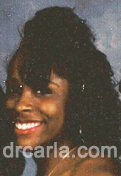
9th Grade (after my first relaxer)
Needless to say, like many girls, I was caught up in trying to conform to the dominant beauty standards I had internalized from my peers and the media that privileged long, straight, bouncy hair. Images that reified White beauty ideals were more pervasive and influential than the few images I saw of Black women with natural hair styles. As a result, I begged my mother repeatedly for permission to get a relaxer to permanently straighten my hair. Most of my Black friends had relaxed hair, which I viewed as a right of passage that I was being denied. My frustrated mother expressed her concern that my hair would be damaged by the chemicals. She tried to convince me that my hair was beautiful the way it was, but I had low self-esteem and was more concerned about what my peers thought about my hair. Despite her better judgement, she finally gave me permission to get my first relaxer when I got my hair done for the 8th grade prom (she also allowed me to get my hair “crimped”). When I entered high school, I started rocking one side of my hair in finger waves, the other side crimped, and the back straight (believe it or not, this was considered “fly” back then). Going to the beauty shop gave me a false sense of maturity and beauty, and after my roots grew in, I became addicted to getting my hair relaxed every 6-8 weeks to maintain my straightened look and elaborate hair styles.
High School, College, & Beyond
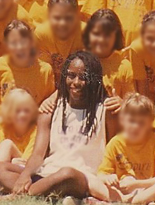
Rising College Freshman (cheerleading camp)
After I entered high school and my awkward puberty years were behind me, I felt confident about my appearance and experimented with different hair styles. I over-processed and damaged my hair on multiple occasions and had to chop it off several times as a result of heat damage. I also wore braids on and off for a few years to give my hair a chance to rest and recover from the self-inflicted abuse. Given the thickness of my hair, it took up to 12 hours to get it braided, which reminded me of my hair braiding sessions during childhood (one stylist attempted to triple her rate because I had “enough hair for three people”).
Although I felt beautiful with my braids, I often encountered conflicting reactions from people of varied racial and ethnic backgrounds that I did not experience when I wore my hair straight. In general, White women and girls often touched my hair (some were polite enough to ask first, but others ran their fingers through my hair without my permission). I even had to ask several young girls to stop putting my hair in their mouths when I was a cheerleading camp counselor in Maryland. One of the White mothers pulled me aside in frustration and revealed that her daughter was obsessed with my hair and begged for braids every day.
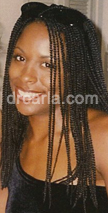
Graduate School
During my years at Spelman College in Atlanta, Georgia, White men often approached me in public places with compliments and questions about my hair. In contrast, I was disheartened when some of my Black male peers revealed their own internalized beliefs about beauty when they asked me in amazement why a “pretty brown-skinned girl with long hair” would choose to wear braids when I didn’t “need” to wear them. When I asked them to explain themselves, they informed me that my darker skinned counterparts wore braids and natural styles out of necessity because their natural hair was short and “nappy” and they couldn’t wear other styles (i.e., long, straight hair). They stared at me in amazement and disbelief when I challenged their attitudes and responded that I wore braids simply because I liked the way they looked.
Similarly, an older relative asked me why I wanted to wear “dreadlocks” since I had “goodish hair” (defined by her as hair that had to be altered to straighten it). I attempted to educate her about the difference between braids and dreadlocks, but she insisted that they were the same. I told her that I was proud of my African heritage and skin color and wore braids because they made me feel beautiful. I had recently read a book about the history and politics of skin color stratification in the African-American community and questioned her perceptions of my hair–but her disapproving comments continued. I felt frustrated and offended that she did not approve of my appearance. Although her comments were hurtful, I was much more confident by the time I entered college and knew that she loved me despite her outdated attitudes. I am grateful that her insensitive comments did not affect my self-esteem or hairstyle choices.
After years of battling with my hair’s natural texture and running from precipitation, I started researching harmful chemicals that are found in many hair products and decided to grow my relaxer out. As my hair grew, I became intrigued by the natural texture that I hadn’t seen since I was 13 and felt sad as I remembered how badly I had wanted to permanently alter my hair during my girlhood. I became frustrated and considered relaxing it again a few times during the two years that it took to grow it out, but I am glad that I didn’t because my hair has never been healthier and I am amazed at how long it’s grown (Update: My hair reached waist length in June 2012). I rarely go to the beauty salon these days (only about once a year to get a professional trim) because I wear my hair in protective, natural styles most of the time and have learned how to take care of my hair, trim my own ends, and keep it healthy. I am also cautious about using too much heat on my hair because I don’t want to damage the natural curl pattern that took so long to grow out.
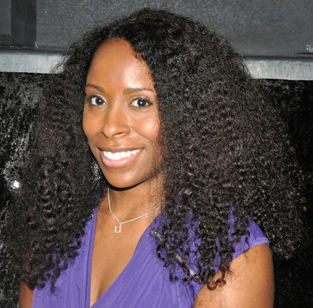
Rocking my natural hair at a party in NYC (Updated June 2012)
I got my last relaxer in December 2006 and I am thrilled that I am now able to enjoy my natural hair the way I did when I was a little girl. I love my big, poofy hair and I am still fascinated that I can do so many different things with the hair God gave me. I can wear it straight, put water on it and watch it transform into curls and waves, or let it dry into a huge ‘fro. Sometimes I even wear my hair in pigtails when I am air drying or setting it at home (my inner researcher loves to experiment with different products and styling techniques).
It feels extremely liberating to no longer allow other people’s opinions and perceptions of beauty to dictate how I decide to style my hair. If anyone objects, I’ll just follow Willow Smith’s advice and “turn my back and whip my hair and just shake ’em off, shake ’em off, shake ’em off….” I wish I had her confidence when I was 9! And if you find yourself struggling to tune out other people’s negative or unsolicited comments about your appearance, I would encourage you to do the same.
After my long journey from feeling oppressed by my hair to learning to love and accept it, I can’t imagine ever mistreating it again. Even though I have days when I am frustrated with my hair, I have learned to appreciate every strand on my head. While the Sesame Street video reminded me that “my hair is an awesome part of me,” the beautiful lyrics from India Arie’s song, “I Am Not My Hair“ summarize how I feel overall:
“…I am not my hair
I am not this skin
I am not your expectations no no
I am not my hair
I am not this skin
I am a soul that lives within…”
* Note to Educators: “Whip My Hair” and “I Am Not My Hair” are great songs to use to spark conversation about body image, self-esteem, peer pressure, and media literacy with girls of all ages and racial/ethnic backgrounds.
Through my hair journey, I have observed that taking care of my hair is similar to caring for a plant. If you neglect a plant, rob it of nutrition, expose it to too much sun, or forget to water it regularly, the leaves will fall off and it will eventually die. But if you appreciate its beauty, nurture it, give it proper nutrition, and shower it with loving care and kind words, the plant will flourish and grow into its full potential. Likewise, it is my hope that I can do my part to help young women and girls appreciate their inner beauty by teaching them tools to help them appreciate, love, nurture, and cherish every part of themselves no matter what they look like on the outside.

Natural Hair Care Blogs and Books
There are a lot of great blogs and books about natural hair care, but these are some of my favorites:
- Follow my “Natural Hair” inspiration board on Pinterest
- The Science of Black Hair by Audrey Davis-Sivasothy (Excellent book about healthy black hair care!)
- Curly Nikki
- Curly Like Me: How to Grow Your Hair Healthy, Long, and Strong by Terri LaFlesh
- Beads, Braids and Beyond (Children’s natural hair care and styling) I wish this site was around when I was a little girl!
- How to Detangle Black Hair
- Sweet Honey Child – This line of products celebrates the beauty and uniqueness of brown-skinned children.
Related Body Image Resources:
- Sign up for my E-mail newsletter and follow me on Facebook and Twitter to receive resources and tips for young women, parents, girls, and girl advocates.
- Dr. Carla’s “I Love My Hair” Conversation Guide & Real Talk™ Self-Esteem Kit for Parents of Girls
- Read my book chapter in “Girl Wide Web 2.0: Revisiting Girls, The Internet, and the Negotiation of Identity” for a research-based exploration of how Black adolescent girls navigate beauty ideals online.
- 101 Ways to Help Your Daughter Lover Her Body by Brenda Lane Richardson and Elaine Rehr
- “You’d Be So Pretty If….Teaching Our Daughters to Love Their Bodies – Even When We Don’t Love Our Own” by Dara Chadwick
- “I Love My Hair” by Natasha Anastasia Tarpley (children’s book)
- “Perfectly You” by Julia V. Taylor (children’s book)
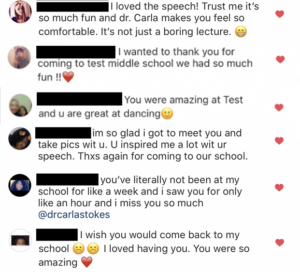
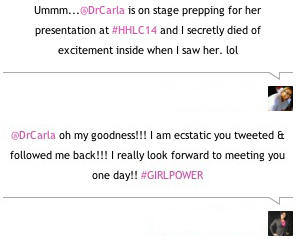



 Facebook
Facebook Twitter
Twitter LinkedIn
LinkedIn Pinterest
Pinterest Youtube
Youtube Instagram
Instagram